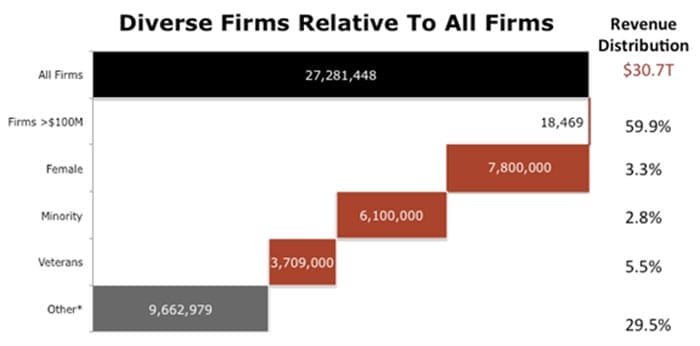Despite numbering more than 50 percent of all firms in the United States, minority and female businesses represent only 6.1 percent of total annual revenue. Since 99.9 percent of all firms fall within the definition of small business, diverse firms also represent more than 50 percent of the small business population. Here are a few more interesting facts about small and diverse businesses:
• More than 50 percent of the working population of about 142 million people is employed by a small business
• Small businesses have generated more than 65 percent of the new jobs during last 20 years
• The number of minority-owned businesses grew nearly 50 percent between 2002 and 2007, nearly three times the rate of all firms in the U.S.
The chart above tells the real story of why supplier diversity matters. Of the more than $30 trillion in annual revenue generated by all U.S. firms, nearly 60 percent is generated by a small group representing less than one-tenth of 1 percent of the U.S. business population. While minority and female-owned firms represent more than 50 percent of the business population, these firms generate just over 6 percent of the total revenue.
What’s even more troubling is the fact that the needle for minority firms hasn’t moved since 1997. While total revenue for all U.S. firms grew 65 percent between 1997 and 2008, from $18.6 trillion to $30.7 trillion, the portion of total revenue generated by minority firms only grew from 2.7 percent to 2.8 percent over the same period.
If supplier diversity is about shifting the lopsided revenue distribution in favor of small and diverse businesses, which ultimately results in jobs growth and positive economic impact, why hasn’t the needle moved?
Supplier Diversity Practices Not Yet Pervasive
When you take a step back and look at the data, the number of companies engaged in the practice of supplier diversity is relatively small. Consider the number of National Minority Supplier Development Council (NMSDC) and Women’s Business Enterprise National Council (WBENC) corporate members as well as other large companies active in supplier diversity. The NMSDC website alone boasts more than 3,500 corporate members, but this is still a relatively low number of participants relative to the universe of U.S. firms.
Given that the practice of supplier diversity is highly concentrated among, and driven by so few large firms focused on the primary metric of Tier 1 spending, you end up with spending concentrated among a relatively small number of diverse suppliers that grow larger. While this is a great outcome, it does not do much in the way of making supplier diversity pervasive across corporate America.
How Do We Make Supplier Diversity Spread Like Wildfire?
Tier 2 should become the new Tier 1. Tier 1 diversity spending is the measure of spending between buyer and diverse supplier. While it is the most direct way to immediately impact an organization’s spending metric, it is not always the easiest to implement and it does not help to spread the “supplier diversity gospel” throughout the supply chain.
On the other hand, Tier 2 diversity spending is the measure of spending between an organization’s Tier 1 suppliers with their diverse suppliers. Many large organizations do business with several thousand suppliers each year, and I know of several organizations doing business with more than 10,000 suppliers. Just imagine the ripple effect of an organization with 10,000 suppliers requiring Tier 2 diversity reporting from all of their suppliers.
This may sound extreme if it were 1980, but technology available today makes it simple to collect this data. Our experience also shows that reporting compliance is extremely high among our best-in-class customers utilizing our Tier 2 tracking and reporting solution.
In my next post, I will dive deeper into how Tier 2 suppliers, if leveraged properly, could be a game-changer for the future of moving the needle on the metrics that really matter.


























